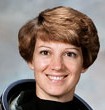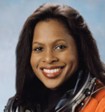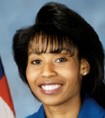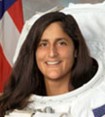| . |
As |
| ASAT |
Anti-satellite weapon. Designed to destroy orbiting satellites |
| Altitude Control System |
Satellite equipment that controls the direction in which the satellite travels |
| astronaut |
a person who travels into space (European term) |
| astronomer |
individual - either scientist or amateur enthusiast - who studies the objects in outer space |
| astronomy |
the study of matter in outer space, such as the positions, dimensions, distribution, motion, composition, energy, and evolution of stars, comets, asteroids, etc. |
| atom bomb |
a bomb which explodes by splitting the nucleus of the atom |
| . |
Bs |
| big bang theory |
theory of the creation of the universe. The universe began about 15 billion years ago with a massive explosion, and continues to expand. |
| . |
Cs |
| capsule communicator (CAPCOM) |
the individual in Mission Control who communicates with the spacecraft |
| cargo bay |
section of the shuttle orbiter which opens into space. |
| Cepheid |
a type of variable star whose brightness varies from bright to faint at a regular interval |
| commander |
the astronaut in chargew of a space mission. Also the pilot of the shuttleduring launch and re-entry. |
| Communication System |
Satellite equipment, such as a receiver and atenna, which recieves instructions from the ground. |
| cosmonaut |
a person who travels into space - Russian term |
| COSPAS/SARSAT |
A Soviet and American satellite that relay distress calls from ships and aircraft. |
| . |
Es |
| deploy |
to place equipment, such as a satellite, in orbit. |
| dock |
to join one space vehicle with another. |
| . |
Es |
| ESA |
European Space Agency. 15 nations united to conduct space research and technology applications. Austria, Belgium, Denmark, France, Germany, Ireland, Italy, the Netherlands, Norway, Spain, Sweden, Switzerland and the United Kingdom |
| EUTELSAT |
A European communications satellite system in orbit above Europe. |
| extravehicular activity (EVA) |
space walks by astronauts. |
| . |
Gs |
| flight engineer |
astronaut in charge of the mechanical performance of the spacecraft |
| . |
Gs |
| galaxy |
a large system of stars held together by mutual gravitation, and isolated from similar systems (galaxies) by vast regions of space |
| Geostationary or Geosynchronous orbit |
A satellite orbit such that it orbits at the same speed as the rotaing earth - so that it remains above the same point on the earth at all times. |
| globular cluster |
a globe-shaped cluster of stars. Each cluster can contain hundreds of thousands of stars. |
| gravity |
the force that attracts objects to each other. |
| . |
Hs |
| Hubble constant |
a number that describes the speed at which galaxies move through space, and how far away they are from observers on Earth. |
| Hubble's law |
the faster galaxies move awar from Earth, the farther away they are |
| Hydrologist |
Scientist who studies the earth's oceans |
| . |
Is |
| infrared |
A form of light, not visible to the human eye, that has a wavelength longer than red visible light. |
| IRAS |
Infrared Astronomical Satellite |
| . |
Ls |
| Landsat |
NASA satellite that studies the landmasses of the earth |
| Laser |
acronym for Light Amplification by Stimulated Emission of Radiation. A machine which produces a pure, highly concentrated beam of light. |
| light-year |
the distance light travels in one year. About 5.9 trillion miles (about 9.46 trillion kilometers) |
| . |
Ms |
| meteorologist |
Scientist who studies the atmosphere and weather of the earth |
| microgravity |
weightlessness in space |
| microwave |
An electromagnetic wave with a wavelength between that of infrared and short waves (one millimeter to one meter). |
| Milky Way |
the spiral galaxy that contains our Solar System |
| Mission Control |
ground-based unit of individuals who monitor and direct the space missions. |
| Mission Simulator |
model of the orbiter's cockpit which allows trainee astronauts to practice their sills |
| MSS |
Multispectral scanner. An instrument aboard Landsat. |
| . |
Ns |
| nebula |
one of four kinds of space formations:
1) clusters of stars
2) shell of gas surrounding a decaying star
3) cloud of space dust and gas
4) very distant galaxies |
| . |
Os |
| observatory |
the building which houses a telescope |
| orbit |
the path which one body moves around another, as satellites around a planet or a planet around a sun. |
| orbiter |
the space shuttle |
| . |
Ps |
| payload |
the cargo, including scientific equipment used for experiments, carried into space. |
| payload commander |
astronaut responsible for the success of experiments on a shuttle mission |
| payload specialist |
person who joins a space mission to conduct specific experiments |
| pilot |
astronaut who flies the shuttle after launch, and co-pilot to the commander at other times. |
| pixel |
picture element. A single point on a photograph. |
| polar orbit |
An orbit that crosses the north and south poles of the moon, used by certain satellites. |
| . |
Qs |
| Quasar |
Quasistelalr object. One of over a thousand known extragalactic objects, starlike in appearance, having spectra with large redshifts. They are thought to be the most distant and most luminous objects in the universe. |
| . |
Rs |
| radio astronomy |
the study of the universe using telescopes which collect invisible rays given off by stars and other space objects. |
| red-shift |
an object that gives off red light, a sign that an object is moving away from the person observing it. Light waves are more spread out, and thus appear redder, as an object becomes more distant. |
| re-entry |
the return to Earth's atmosphere |
| reflecting telescope |
telescope which collects rays of light and reflects them with mirrors to produce a magnified image. |
| remote manipulator system (RMS) |
robotic arm in the cargo bay of the shuttle |
| . |
Ss |
| satellite |
An object (natural or artificial) that orbits a larger body. |
| solid rocket booster |
one of two rockets filled with solid fuel to provide extra launching power for the shuttle. |
| space |
the area above the earth's atmosphere (50 miles). |
| spectroscopy |
method of measuring the chemical composition of objects, by passing the rays of light htey give off through special gases. |
| spectrum |
the pattern formed by light rays as they pass through gases during the process of spectroscopy. |
| Sputnik |
the first Russian satellite, and the first man-made satellite in orbit. Sputnik is the Russian word for satellite. |
| star atlas |
collection of maps, charts and photogrpahs showing the stars in the sky. |
| . |
Ts |
| theory of relativity |
two theories suggested by Albert Einstein. Special relativity in 1905, general relativity in 1915. |
| thrust |
forward or upward push created by gases escaping through engines. |
| . |
Us |
| ultraviolet |
light not visible to the naked eye, with wavelengths shorter than visible violet light. |
| . |
Xs |
| X-rays |
A high-energy form of light invisible to the naked eye. Has shorter wavelengths than ultra-violet light. |



